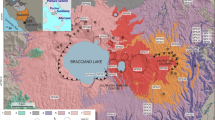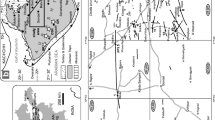Abstract
In this paper a model is presented for the geochemical evolution of Mars which is constrained by the isotope systematics of Pb, Nd, and Sr determined for SNC meteorites (SNCs). The young magmatic crystallization ages (internal or mineral ages) of SNCs may indicate that these meteorites indeed stem from Mars. Internal ages and U-Pb and Pb-Pb systematics strongly suggest that they are the result of two magmatic processes. In addition, shock metamorphism is implied from observed petrographic shock features. For ALHA 77009 a shock-age < 15 Ma is obtained which is within uncertainty identical to the independently determined cosmic ray exposure age. It is therefore plausible that shock and exposure ages are identical for all SNCs. The Rb/Sr data of all common (non-SNC) meteorites form a 4.55 Ga isochron as do the Pb-Pb data (geochron). The SNC data fall close to these two isochrons. The Sr and Pb isotopic compositions in SNCs suggest that they formed in a recent (1.3-0.15 Ga) melting event from reservoirs which had been magmatically differentiated 4.3 ± 0.2 Ga ago. In a concordia diagram (U-Pb evolution plot) the SNC data reflect recent increase of the U/Pb ratio and the same two stage magmatic history as suggested by the other isotopic systems. The oxygen isotopic composition as well as the Nd isotopic systematics strongly suggest that the SNCs stem from one common reservoir which chemically differentiated 4.3 ± 0.2 Ga ago and then formed sub-reservoirs. In contrast to common meteorites, SNCs experienced an early magmatic differentiation where the Sm/Nd, U/Pb and Rb/Sr ratios have been strongly fractionated. In the recent magmatic process (1.3-0.15 Ga ago), in which the SNCs were formed as rocks, Sm/Nd and U/Pb were fractionated, while Rb/Sr remained similar to that of the source from which the magmas originated. During these melting events, mixing of components from different sub-reservoirs might have had occurred. At least three subreservoirs are necessary to explain the isotopic variations observed in SNCs. In contrast to the isotopic evolution of the Earth, Mars conserved remnants of the primary differentiation, a fact, which places important constraints on the tectonic evolution of Mars.
Similar content being viewed by others
References
Bogard, D. D. and Husain, L.: 1977, Geophys. Res. Lett. 4, 69–711.
Bogard, D. D., Nyquist, L. E., and Johnson, P.: 1984, Geochim. Cosmochim. Acta 48, 1723–1739.
Chen, J. H. and Wasserburg, G. I.: 1986, Geochim. Cosmochim. Acta 50, 955–968.
Gale, N. H., Arden, J. W., and Hutchison, R.: 1975, Earth Planet. Sci. Lett. 26, 195–206.
Hart, T. and Brooks, C.: 1977, Contrib. Mineral. Petrol. 61, 109–128.
Jagoutz, E. and Wänke, H.: 1986, Geochim. Comocim. Acta. 50, 939–953.
Jagoutz, E.: 1988, Lunar Planet. Sci. Conf. XX, 450–451, The Lunar Planetary Institute, Houston.
Jagoutz, E.: 1989, Geochim. Cosmochim. Acta 55, 2429–2441.
Minster, J.F. and Allegre, C.J.: 1979, Meteoritics 14, 235–248.
Nakamura, N., Unruh, D. M., Tatsumoto, M., and Hutchison, R.: 1982, Geochim. Cosmochim. Acta 46, 1555–1573.
Nyquist, L. E., Wooden, J., and Bogard, D. D.: 1979, Geochim. Cosmochim. Acta 43, 1057–1074.
O'Nions, R., Hamilton, P., and Evenson, N.: 1977, EPSL 34, 13–22.
Papanastassiou, D. A. and Wasserburg, G. J.: 1974, Geophys. Res. Lett. 1, 23–26.
Podosek, F. A.: 1973, Earth Planet. Sci. Lett. 19, 135–144.
Shih, C. Y., Nyquist, L. E., Bogard, D. D., McKay, G. A., Wooden, J. L., Basnal, B. M., and Wiesmann, H.: 1982, Geochim. Cosmochim. Acta 46, 2323–2344.
Shergotty Consortium and SNC Meteorites: 1986, Geochim. Cosmochim. Acta 50, 875–1071.
Wooden, J., Shih, C. Y., Nyquist, L., Bansal, B., Wiesmannn, H., and McKay, G.: 1982, Lunar Planet. Sci. Conf. XIII, 879–880.
Author information
Authors and Affiliations
Rights and permissions
About this article
Cite this article
Jagoutz, E. Chronology of SNC meteorites. Space Sci Rev 56, 13–22 (1991). https://doi.org/10.1007/BF00178386
Received:
Issue Date:
DOI: https://doi.org/10.1007/BF00178386




